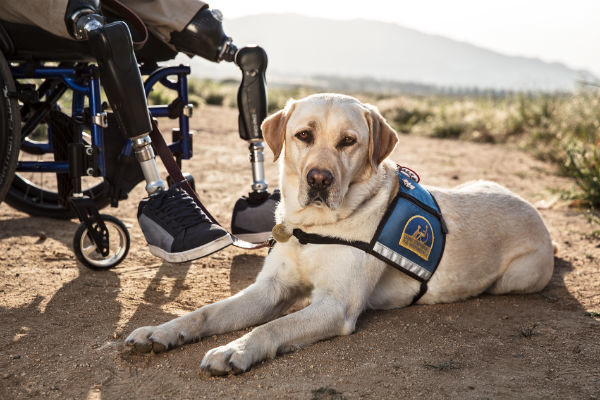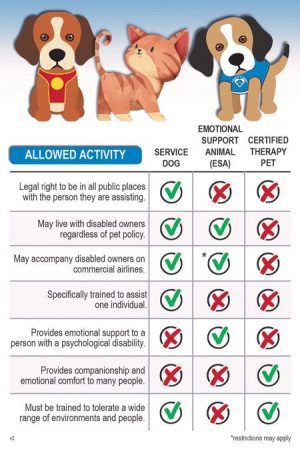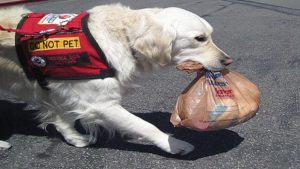What you may not know about service dogs

September 15, 2019
I have a service dog named Cinch, who was born in Woodlake, California. A golden retriever, the most common breed for service dogs, Cinch was one of the two puppies in a small litter, and the other puppy in the litter was his sister, Valentine. I got him from the ASDEC (Assistance Service Dog Educational Center.) He was born on Valentine’s Day of 2015, and his training began when he was two years old. My brother and I spent about a month with the ASDEC–training different dogs weekly. Finally, Ivory, a companion dog, chose Wade; and Cinch chose me.
The ASDEC is a place where people afflicted with disabilities go to obtain service animals. Service dogs are trained for specific reasons, such as anxiety, seizures, blindness, deafness, severe PTSD, and more. When people think of service dogs, they may first think of seeing eye dogs, but their abilities vary. Commands for dogs at the ASDEC fall into the categories of assisting humans with everyday actions such as opening a door, putting on clothes, or walking down a flight of stairs. Dogs can even be trained to remind people to take medications on time, to apply pressure to relive a panic attack, or to retrieve a phone in the case of an emergency. I met a man named Shane, a person afflicted with seizures, who was training a dog to alert him when he was about to have a seizure so that he could be in a safe position. My case is anxiety, and Cinch is trained to help me with that by sensing my emotions, being near me, letting me hug him, licking me, and offering affection.
Sometimes there is confusion between service dogs and regular dogs. The Americans with Disabilities Act (ADA) defines a service dog as “…any dog individually trained to do work or perform tasks for the benefit of an individual with a disability, including a physical, sensory, psychiatric, intellectual, or other mental disability.”
 According to Orvis, a service dog is not the same as an emotional support dog (ESD). ESDs are prescribed by a doctor or a licensed therapist to provide a therapeutic benefit. ESDs are trained to be calm, well-behaved, and affectionate, but they do not have specialized training to perform tasks for a certain illness or disability. The other difference between Emotional Support Dogs and service dogs is that service dogs can go anywhere its handler does, including restaurants, hospitals, and other places where animals are usually off-limits. ESDs can accompany owners on flights and can live with them regardless of a building’s pet policy, but they are not allowed to visit public places.
According to Orvis, a service dog is not the same as an emotional support dog (ESD). ESDs are prescribed by a doctor or a licensed therapist to provide a therapeutic benefit. ESDs are trained to be calm, well-behaved, and affectionate, but they do not have specialized training to perform tasks for a certain illness or disability. The other difference between Emotional Support Dogs and service dogs is that service dogs can go anywhere its handler does, including restaurants, hospitals, and other places where animals are usually off-limits. ESDs can accompany owners on flights and can live with them regardless of a building’s pet policy, but they are not allowed to visit public places.
 There are also therapy dogs, which are a part of someone’s treatment. These dogs do not have any legal rights to be on public property. While Service Dogs and ESDs usually work with just their owners, therapy dogs work with groups of people. According to the Alliance of Therapy Dogs, “Sometimes a therapy dog will be a permanent resident of an establishment with lots of different patients or visitors, like a nursing home, physical rehabilitation facility, or psychologist’s office. Other therapy dogs frequently visit daycare facilities, schools, libraries, group homes, hospitals, airports and in many other venues where needed.”
There are also therapy dogs, which are a part of someone’s treatment. These dogs do not have any legal rights to be on public property. While Service Dogs and ESDs usually work with just their owners, therapy dogs work with groups of people. According to the Alliance of Therapy Dogs, “Sometimes a therapy dog will be a permanent resident of an establishment with lots of different patients or visitors, like a nursing home, physical rehabilitation facility, or psychologist’s office. Other therapy dogs frequently visit daycare facilities, schools, libraries, group homes, hospitals, airports and in many other venues where needed.”
With several types of dogs as well as regular pets, there may be confusion about which dogs are permitted. At the ASDEC, the owner receives a stack of cards that are given to parties that question the presence of the dog. The card states that this dog is a service/companion dog. If the business continues to question the dog, then the law gets involved. Business owners are only allowed to ask if a dog is a service animal and what tasks the dog is trained to perform. Any additional questioning is a violation of the Americans with Disabilities Act.
 The ASDEC is not the only place that trains service dogs. There are K-9 service dog trainers elsewhere who follow similar rules and train similar skills. Service dogs train daily for at least a year, sometimes two. Not all dogs who begin training can become service dogs. They must not only learn to perform specific tasks to help the owner but also must learn to resist all temptations and distractions including sounds, people, and food smells. Some dogs must even learn all of this without verbal commands. There are flashcards for people who can’t speak the commands to the dogs, but the dog has to learn to read English or pictures so that those commands can be carried out.
The ASDEC is not the only place that trains service dogs. There are K-9 service dog trainers elsewhere who follow similar rules and train similar skills. Service dogs train daily for at least a year, sometimes two. Not all dogs who begin training can become service dogs. They must not only learn to perform specific tasks to help the owner but also must learn to resist all temptations and distractions including sounds, people, and food smells. Some dogs must even learn all of this without verbal commands. There are flashcards for people who can’t speak the commands to the dogs, but the dog has to learn to read English or pictures so that those commands can be carried out.
Because service dogs are always working–focused on monitoring or assisting their owners, they cannot be pet or approached. People should not even ask to pet a service dog.
For me, Cinch is one-of-a-kind. He and Ivory have affected me and my brother’s lives forever. They chose us, and by giving them love in return for what they have done for us, we have formed an amazing bond. For the half million people in the United States currently helped by a service dog, they know how important these animals can be.











